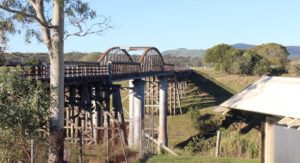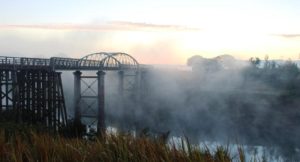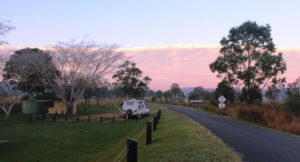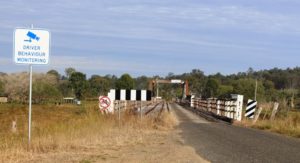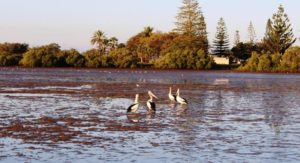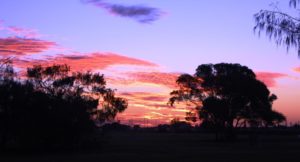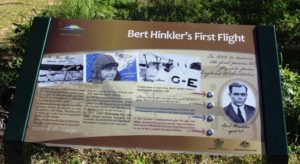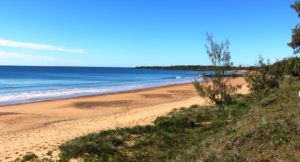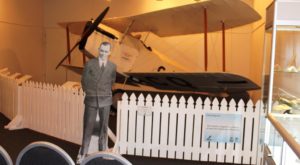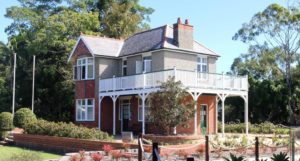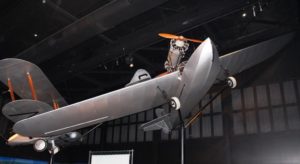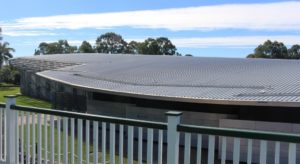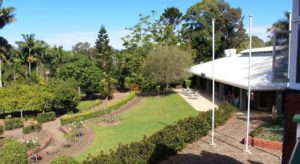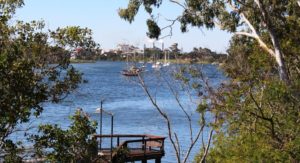Some time ago, someone posted somewhere, a photo of Dickabram Bridge with a comment about an adjacent peaceful camping area. I noted it for future reference. When we settled with the Keith an Linda Giles on Burnett Heads as a meeting point we were committed to yet another trip up the Bruce Highway, but we wanted an overnight stop away from highway traffic. Dickabram Rest Area was just the ticket.
The turn from the highway is to the left at the small town of Gunalda, about 15 km north of the intersection of the Bruce Highway with the Wide Bay (or Bunya) Highway. The road is narrow but sealed and passes through woodlands and cane fields. The bridge carries the road over the Mary River near the remains of the town of Miva. The road then joins the Bauple Woolooga Road. This makes it something of a short cut to the South Burnett area, as we found during the afternoon and evening.
The bridge is heritage listed, as it is one of two of its kind in Australia. It has two lanes, one that carries road traffic and one that formally carried the railway. The line has long been closed, but the rails remain. The bridge is mainly of timber construction with a planked deck, the planks running at right angles to the direction of travel. We lived within hearing distance to a bridge planked in this manner when I was a child. They are a recipe for noise.
A unique feature of the bridge is the steel tube trusses that support the centre part that is actually over the river itself. The other trusses are of timber. The bridge was opened in 1886, completing a link to Kilkivan. The structure is 191 meters long and stands 23 meters above the river. Its decking has only once been under flood waters, quite early in its life, in 1893, but many floods have raged between its trusses since then, without bringing it down.
There is not much left of Miva. Its heyday seems to have been during bridge construction, when it was one of those towns that boasted a butcher, a baker and a candle stick maker and three pubs!
The camping area was quite, except when a vehicle was crossing and that occurred frequently during the late afternoon and quite a few times during the night. We were the only residents overnight but did entertain a travelling couple to afternoon tea. We took pity on them. Their caravan was damaged and they had been waiting for two weeks for it to be repaired and were living in a cabin at Gunalda while they waited. They had visited the bridge to help fill in some time. We assisted by extending the time taken for their visit to the bridge.
The next day we made our way back over the bridge as we moved on to Bundaberg and Burnett Heads. As had been the case the day before, we met an endless stream of caravans coming south. We arrived at the Burnett Heads Caravan Park at about 1.30 pm to find Keith and Linda Giles two caravans ahead of us in the check in queue.
The arrangement was really about spending some time with them, but on Wednesday we went together to visit the Hinkler Hall of Aviation. Almost everyone has heard of aviator Bert Hinkler and most people know that his home was in Bundaberg. He came to fame in Europe but it all started in Bundaberg.
I had no idea that he designed and built his own glider, taking inspiration for his design from the study of the ibis. His glider actually flew a mere ten years after the Wright Brothers first successful flight, on what is now Mon Repos Beach, now better known for its popularity with the Loggerhead Turtle as a breeding ground. It was named after Hinkler’s home in England. This house now stands in the gardens at Bundaberg North, having been reconstructed brick by brick after being dismantled and moved to Bundaberg.
We visited the house several years ago. Now it stands next to a large building that contains the story of Hinkler’s life and many of the aircraft, some of them replicas, with which he was involved throughout his life. He became a pilot, served with distinction during the First World War, reaching the rank of Squadron Leader, and of course was the first aviator to fly solo from England to Australia. But he was a gifted engineer and inventor. Many of his inventions are still in use today.
The Hall of Aviation is an extensive building with a roof shaped in the style of an aircraft wing. Inside is an extensive display that features several aircraft but has video booths, wall mounted illustrated story boards, flight simulators and even simulators that allows visitors to experience the sensation of flying a glider of the type that Hinkler built.
A visit is to be absolutely recommended.
We returned to the city area to lunch, overlooking the Burnett River and after a bit of essential shopping returned to Burnett Heads for a second communal evening meal. This morning Keith and Linda continued their journey home to Castlemaine and we moved north to Baffle Creek for a couple of nights. We will post from Baffle Creek if anything worth reporting should occur.
Baffle Creek, incidentally, is south of the town of Seventeen Seventy. This part of Queensland is known as the Discovery Coast.

